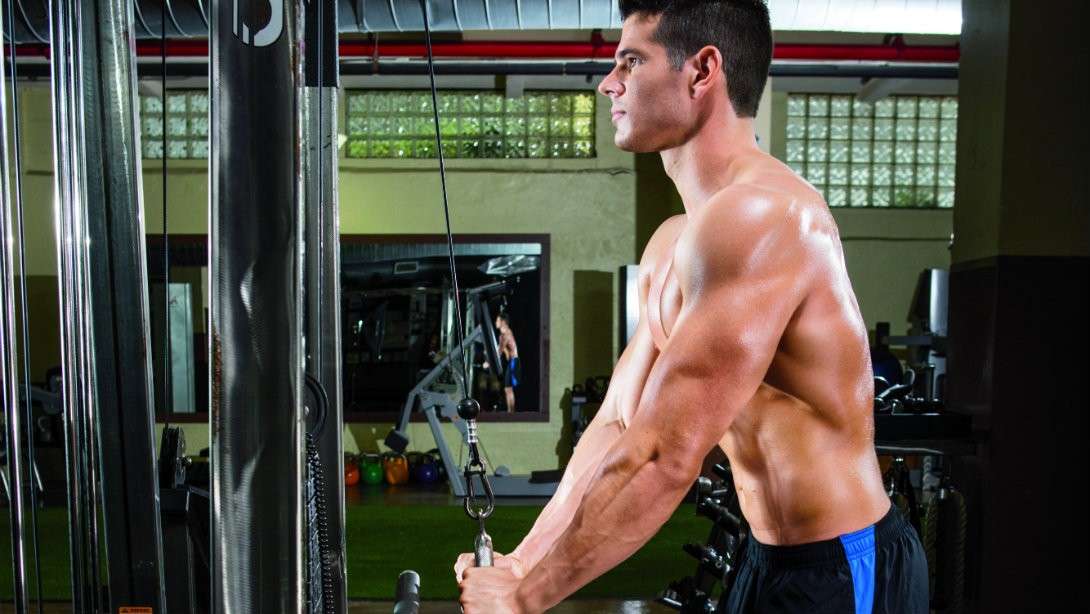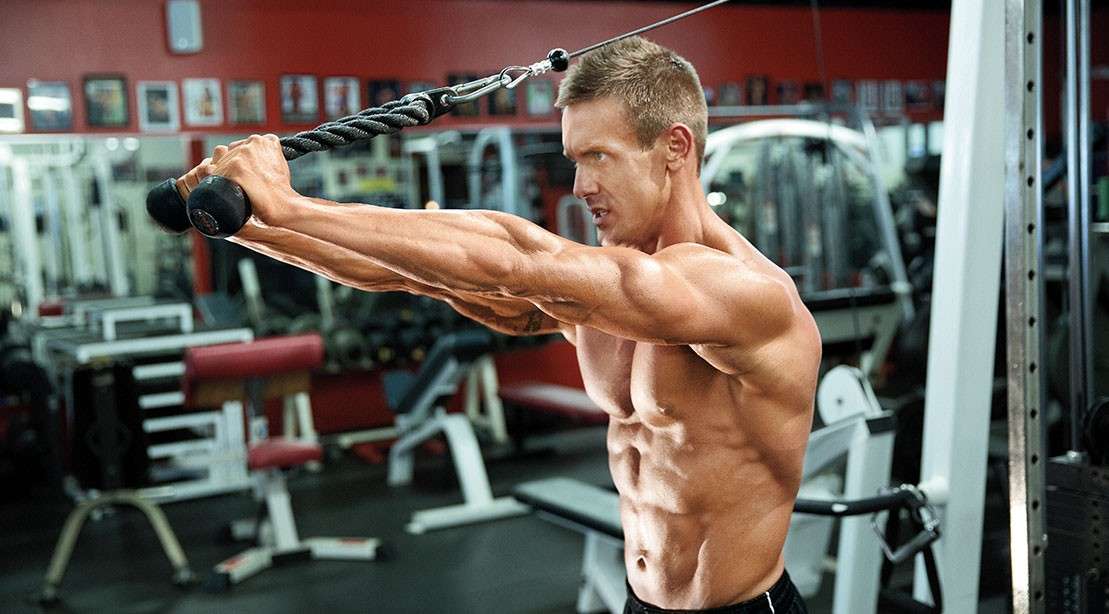Introduction
How To Work Inside Tricep: The triceps brachii is a three-headed muscle located on the back of your upper arm. These three heads are the lateral head, the long head, and the medial head. The inside of the triceps refers primarily to the medial head. It’s important to distinguish between these heads because targeting them individually can help you achieve a balanced and well-defined arm.
Focusing on the inside tricep is crucial for a balanced arm development. It contributes significantly to the overall size and shape of your arm, especially when viewed from the front. By strengthening and sculpting the medial head, you can create a more impressive and defined arm appearance.
Developing the inside tricep can help create a fuller and more symmetrical appearance to your arm. Enhanced functional strength: A strong inside tricep assists in various pushing movements, such as bench presses and dips. Injury prevention: A balanced arm, including the inside tricep, can reduce the risk of imbalances and related injuries.

Which tricep exercises hit which head?
“For the lateral head, overhead cable tricep pushdowns/extensions seem to be the best option whereas the rope tricep pushdowns/extensions seems to be the best option for the medial head (and for overall triceps development).”
Lateral Head
Tricep Pushdowns: Using a cable machine with a straight bar attachment and a pronated grip (palms facing down), tricep pushdowns primarily engage the lateral head.
Close-Grip Bench Press: While this exercise engages all three tricep heads, a narrower grip places more emphasis on the lateral head.
Medial Head
Close-Grip Bench Press: As mentioned earlier, this exercise works the medial head along with the other heads, but it’s one of the most effective movements for targeting the inside triceps.
Diamond Push-Ups: A bodyweight exercise that places considerable emphasis on the medial head. To perform, place your hands close together beneath your chest, forming a diamond shape with your thumbs and index fingers.
Long Head
Overhead Tricep Extensions: Performed with a dumbbell or barbell, this exercise involves extending the arms overhead and primarily targets the long head of the triceps.
Incline Tricep Extensions: Performed on an incline bench, this exercise targets the long head by extending the arms overhead at a different angle.
Do I need to hit the triceps directly?
At this stage, direct arm work isn’t necessary and shouldn’t play a big role in the workout. However, as the individual gets stronger and bigger but has yet to achieve his physique goals, he might find that he needs to devote time to direct biceps and triceps work.
Aesthetic Development
Balanced Appearance: Direct triceps work can help create a balanced and symmetrical arm appearance. Neglecting the triceps may result in disproportionately smaller arms, particularly when compared to well-developed biceps.
Definition and Tone: Isolation exercises targeting the triceps can enhance muscle definition and tone, providing a more sculpted look to your arms.
Improved Strength
Enhanced Pushing Power: Strengthening your triceps directly can significantly boost your pushing strength, which is essential for exercises like bench presses, overhead presses, and push-ups.
Functional Fitness: Strong triceps are vital for everyday activities, such as lifting, carrying, and pushing objects, as well as maintaining proper posture.
Injury Prevention
Muscle Imbalance: Neglecting the triceps in your training routine can lead to muscle imbalances between the front (biceps) and back (triceps) of your arms. This imbalance may increase the risk of injury and affect your joint health.
Elbow and Shoulder Stability: Well-developed triceps help stabilize the elbow and shoulder joints, reducing the risk of strains and overuse injuries.
Are triceps hard to build?
The triceps have three muscle heads. To get balanced arm growth, you need to spend at least 33% more time on them. If you have an hour for arm day, you would dedicate 35 minutes to triceps versus 25 for biceps.
Several factors contribute to the perception that triceps are difficult to build:
Genetics: Genetics play a significant role in muscle development. Some individuals naturally have more favorable genetics for building triceps, while others may find it more challenging.
Overtraining Mistakes: Many people make the mistake of overtraining their biceps and neglecting their triceps. Balancing your arm training and giving equal attention to both muscle groups is crucial for overall arm development.
Proper Technique: Achieving optimal muscle activation in the triceps requires proper exercise technique. Poor form during triceps exercises can lead to ineffective workouts and limited muscle growth.
Plateauing: Like any muscle group, the triceps can reach a plateau if you don’t continually challenge them with progressive overload (increasing the weight or resistance over time).
Nutrition: Building muscle requires adequate nutrition, including protein intake. If you’re not providing your body with the right nutrients, your triceps (and other muscles) may struggle to grow.
Do triceps need heavy weights?
Julian recommends 4 to 6 sets of 6 to 12 reps for the best results. Since the triceps are a very fast-twitch dominant muscle group, they respond very well to heavier loads and a lower to medium rep range.
While heavy weights can certainly be effective for stimulating muscle growth, they are not the only way to achieve it. The triceps can respond to a variety of weight ranges, and the key is to find the appropriate intensity that works for you. Here’s how both heavy and moderate weights play a role in triceps training:
Heavy Weights
- Lifting heavy weights, often in the lower rep range (e.g., 4-6 reps), can place a significant load on the triceps.
- This approach is effective for developing strength and can lead to muscle growth, particularly in the early stages of training.
- Exercises like the close-grip bench press and weighted dips can be used with heavy weights to target the triceps.
Moderate Weights
- Using moderate weights with higher repetitions (e.g., 8-12 reps) can also promote triceps growth.
- This approach may be gentler on the joints and connective tissues, reducing the risk of injury compared to consistently lifting very heavy weights.
- Exercises like tricep pushdowns, tricep extensions, and skull crushers are commonly performed with moderate weights.
Can I train my triceps everyday?
You can train your triceps daily, but I wouldn’t recommend it. Sure, there are daily push-up challenges, but the loading from push-ups is low, and you rarely go to true failure often. Instead, 2-3 times per week of targeted triceps training will get you all the gains you’re after.
While it may be tempting to train your triceps every day in pursuit of rapid growth, doing so can lead to overtraining and potential injury. Here are some guidelines to help you determine an appropriate triceps training frequency:
Allow for Recovery: The triceps, like any muscle group, require adequate time to recover. A common guideline is to allow at least 48 hours of recovery between triceps-focused workouts.
Train Smart: Focus on quality over quantity. Ensure that each triceps workout is effective and efficient, targeting all three triceps heads.
Listen to Your Body: Pay attention to signs of overtraining, such as excessive soreness, decreased strength, or joint pain. If you experience these symptoms, consider reducing training frequency.
Split Training: Incorporate triceps training into a well-rounded workout routine that includes other muscle groups. This allows you to work your triceps without overloading them daily.
Variation: Vary your triceps exercises and rep ranges to prevent plateaus and reduce the risk of overuse injuries.
Progressive Overload: Instead of increasing training frequency, focus on progressive overload by gradually increasing the weight or intensity of your triceps exercises.
How many sets do triceps need?
Most intermediate-advanced lifters need at least 6 sets of direct triceps work per week to make gains, and for some, it’s even more than that. This is ON TOP OF normal chest pressing. If you’re training twice a week, that’s about 3 sets per session.
To determine the optimal number of sets for your triceps training, consider the following guidelines:
Training Frequency
Consider how frequently you train your triceps. If you work your triceps more frequently (e.g., twice a week), you may need fewer sets per session compared to less frequent training (e.g., once a week).
Exercise Variety
Incorporate a mix of triceps exercises in your routine to target all three triceps heads. Diversifying your exercises can reduce the need for excessive sets.
Progressive Overload
Prioritize progressive overload by gradually increasing the weight or resistance as your strength improves. This can be more important than the number of sets.
Listen to Your Body
Pay attention to your body’s response. If you feel adequately fatigued and experience muscle soreness after a workout, you’re likely hitting the right set volume.
Do big triceps look good?
The triceps muscles are at the back of the upper arm. Big triceps make your arms look better, even with adequate biceps muscle. Don’t neglect them. Build up your triceps with exercises like pushdowns, overhead extensions, and dips.
While the visual appeal of big triceps is undeniable, their benefits go beyond aesthetics:
Increased Strength: Developing strong triceps is essential for various functional movements, including pushing and pressing exercises. Strong triceps can enhance your strength in activities like bench presses, push-ups, and overhead presses.
Improved Performance: Athletes in sports like weightlifting, powerlifting, and martial arts rely on strong triceps for optimal performance. Powerful triceps can assist in generating force and stability during athletic movements.
Reduced Risk of Injury: Well-conditioned triceps can help stabilize the shoulder joint, reducing the risk of shoulder injuries during workouts and daily activities.
Functional Movements: Everyday activities, such as lifting objects, pushing doors, and carrying groceries, often engage the triceps. Having strong triceps can make these tasks easier and less physically demanding.
Do triceps make arms bigger?
Although most people who want to know how to build arm muscle focus on biceps training, if you want really big arms then you need to work your triceps and brachialis just as hard. To get a truly sleeve-busting look, you need to work the triceps, biceps and the brachialis.
While the biceps often receive more attention for their aesthetic appeal, the triceps play a crucial role in overall arm size and definition. Here’s how the triceps contribute to making your arms look bigger:
Triceps Account for More Mass: The triceps actually make up a larger portion of the upper arm than the biceps. In fact, about two-thirds of the arm’s muscle mass is the triceps.
Arm Symmetry: Well-developed triceps create symmetry in the arms. When the triceps are proportionally developed, they provide a balanced appearance when compared to the biceps.
Arm Definition: Developing the triceps adds definition and contours to the back of the arm, which contributes to the overall appearance of arm size and muscularity.
Sleeve Filling: If you enjoy wearing short sleeves or sleeveless clothing, strong and developed triceps can give your arms a fuller and more robust appearance.

Conclusion
While we mentioned some effective exercises earlier, it’s important to emphasize the importance of variety in your workout routine. By incorporating a range of exercises that target the inside tricep, you can prevent plateaus and continue making progress. Include variations of close-grip bench presses, such as incline or decline versions, to work the inside tricep from different angles.
Building muscle in the head tricep (or any muscle group) also depends on your nutrition and recovery habits. Ensure you’re consuming enough protein to support muscle repair and growth. A balanced diet rich in nutrients and adequate hydration is essential. Prioritize quality sleep and allow adequate time for muscle recovery between workouts to maximize your progress.
To continually challenge the inside tricep, consider implementing periodization into your training routine. Periodization involves varying your training intensity, volume, and exercises over time to prevent adaptation and stagnation. Progressive overload is a key principle in strength and muscle building; it involves gradually increasing the resistance or weight you lift to stimulate muscle growth.

